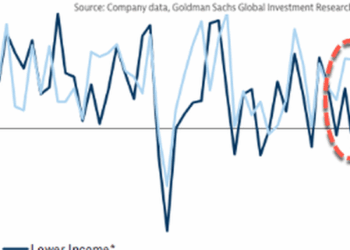
After years wandering in the wilderness, the Republican Party is finally making inroads into the female vote. While Democrats held a +15 advantage among women in the 2016 presidential election, that gap narrowed to a +7 margin by 2024. Amy Coney Barrett, a brilliant conservative jurist with seven children, sits on the Supreme Court and is likely to be the deciding voice in many critical cases. Katie Britt, a Republican senator and rising star in the party, has school-aged kids. There are hopes that Erika Kirk, the charismatic widow of Charlie Kirk, can help bring more young women—the demographic that currently is most hostile to conservative principles—into the party.
This is in stark contrast to the Democrats, whose gender dynamics could charitably be called a fiasco. They damaged their brand among women by (among other things) endorsing lengthy school closures during COVID, and “recast[ing] as villains … white women.” Democrats have also hobbled themselves among young men. For years, according to Laura Kennedy, a freelance journalist, “womanhood was presumed inherently virtuous … every male-dominated space was presumed to be corrupt and exclusionary, and every observable sex difference was explained away as social conditioning.” The liberal struggle for gender equality has often pitted women and men against each other in a zero-sum game: For women to advance, men must step aside.
While Democrats struggle to contain the fallout from this gender war, a new front in the battle of the sexes has recently been opened by some conservative thinkers. It rests on a theory, nicknamed “The Great Feminization,” that posits that our institutions have become more and more “feminine”—and claims that’s generally a bad thing.
Although interest in “The Great Feminization” has been building for a while, it exploded recently with a viral essay by Helen Andrews, a conservative commentator. In it, Andrews argues that female group dynamics are responsible for “wokeness” and “cancel culture,” which she describes as “simply feminine patterns of behavior applied to institutions where women were few in number until recently.” Andrews argues that corporate cultures often suffer when they become majority female, and she worries particularly about the impact of gender dynamics on law. Too many women lawyers, she suggests, might well bring down the American legal system:
The field that frightens me most is the law. All of us depend on a functioning legal system, and, to be blunt, the rule of law will not survive the legal profession becoming majority female. The rule of law is not just about writing rules down. It means following them even when they yield an outcome that tugs at your heartstrings or runs contrary to your gut sense of which party is more sympathetic.
Andrews concludes that while it is “still controversial” to argue that “there are too many women in a given field or that women in large numbers can transform institutions beyond recognition in ways that make them cease to function well,” it is necessary to do so because “we all are … dependent on institutions like the legal system, scientific research, and democratic politics that support the American way of life, and we will all suffer if they cease to perform the tasks they were designed to do.” In a speech at the National Conservatism Conference last month, Andrews argued that “a thoroughly feminized civilization will set itself on the road to collapse.” Although Andrews is careful to point out that she doesn’t want to roll back women’s rights (and acknowledges that individual women can pursue professional excellence), she hopes the trend of feminization will reverse if we take what she sees as needed steps to abandon our “system in which it is illegal for women to lose” and “[r]emove the HR lady’s veto power.” While Andrews is cagey about what future she hopes for, she’s explicit that institutional threats remain “as long as demographics remain unchanged.” She doesn’t say where she wants the apparently too many working women to go.
The essay is notable not only for how much interest it generated, but also how many positive comments it received among pundits. One female business leader called it a “seminal essay,” while a professor at Duke said it “contains far-reaching hypotheses that academics should take seriously and test rigorously.” And it seems to have spread beyond the writerly class: Andrews’ tweet of her essay has, as of this writing, racked up 6.4 million views.
But there are significant reasons to doubt Andrews’ thesis. For one, although Andrews claims that feminization will destroy the practice of law because women lawyers will fail to follow the rules if they “yield an outcome that tugs at your heartstrings,” extensive research has already been conducted into differences in behavior between male and female judges. One study of judges in North Carolina found that, contra Andrews, “women on the bench tend to be less lenient than their male counterparts.” While the study author cautioned that her findings were not necessarily statistically significant, they certainly point away from the “female judges as bleeding hearts” hypothesis. Similarly, another study found that “for ‘high harm crimes,’ young female judges on average sentenced offenders to 24% more incarceration (4.9 years more) than did their male colleagues and to 25% more incarceration (5.1 years more) than did their older female colleagues.” Furthermore, attributes that Andrews identifies as “feminine,” such as empathy, can often be assets in the legal field. Consider a prosecutor charged with shepherding a girl who has been sexually assaulted through the legal process. This prosecutor must both be able to create a rapport with a deeply traumatized child—a tremendously difficult task requiring significant emotional intelligence—and zealously pursue the perpetrator in order to achieve justice. Attorneys in arbitrations, amicable divorce cases, elder law (which often involves navigating difficult family dynamics), etc., must all draw on conflict resolution skills, contra what Andrews calls the male tendency to “wage conflict openly.”
Likewise, although Andrews claims that the “Great Feminization” theory explains why “wokeness” arose because it occurred “around the same time that many important institutions tipped demographically from majority male to majority female,” it’s hard to follow her timing. For example, while women earned more bachelor’s degrees than men starting in the 1980s, only 36 percent of full professors are women. (And it’s full professors who are usually tasked with tenure decisions and significant administrative responsibilities.) So it is still difficult to explain why academic cancel culture began to occur decades after women made up most of the undergraduate population, yet before women were a majority of full professors.
Indisputably, the top brass of corporations remains mostly male: In 2024, only about 10 percent of CEOs at Fortune 500 Companies were female, and recent reporting notes women make up only around 25 percent of the equity partners in legal private practice. These stats temper Andrews’ claim that our current system “makes it illegal for women to lose:” While women are gaining ground, they’ve certainly not swept the field.
Why has “wokeness” allegedly been so successful in hierarchical organizations where the boss or leadership structure remains much more likely to be male than female? Andrews makes no attempt to disambiguate the role of social media or Slack channels (both also recent developments) as potential contributors to the phenomenon she identifies; nor does she provide any explanation of why cancel culture took root so powerfully in academia, rather than some other historically female profession. Cancel culture seems to have started from the bottom and worked its way up, but why were many male-dominated bureaucracies willing to bow to the “cancelers” rather than fire troublemakers?
Scholars should, of course, continue to research gender workplace dynamics. One of the authors Andrews cites in support of her thesis, the behavioral scientist Cory Clark, released excerpts of a forthcoming paper shortly after Andrews’ essay was published. Clark (like Andrews), believes men and women do display different average characteristics: “Women are more risk-averse and egalitarian, more concerned with protecting the vulnerable, and more inclined to resolve conflict through social exclusion.” She goes on to state: “Men and women both have values and behavioral proclivities that can be constructive and destructive in different contexts.” Clark (like Andrews) believes women have changed academic institutions to pursue harm-avoidance and cancel culture. She notes, however, that male-dominated organizations suffer from their own problems: “Men, with their tendencies toward conquest and sexual and physical violence, do not fit perfectly within modern institutions, and societies for millennia have paid enormous costs to tame aggressive male behavior.” She suggests that rather than “oversimplf[y] the relationship between female priorities and cultural outcomes,” societies should strive to “benefit from the best aspects of both male & female psychology.”
This is a good warning—don’t dwell on potential female vices while ignoring female virtues or male vices—but oversimplification seems to abound anyway. For example, Andrews laments: “You can have an academia that is majority female, but it will be (as majority-female departments in today’s universities already are) oriented toward other goals than open debate and the unfettered pursuit of truth.” This ignores that scholarly communities have always struggled to balance truth-seeking with other goals. During the McCarthy era, for example, universities often were subject to bitter infighting while trying to weigh principles of academic freedom against national security concerns. Whatever academia was before women came along, it wasn’t a placid Ivory Tower solely devoted to objective research.
As academic research continues on this subject, conservative politicians and policymakers should reject the cartoon version of the “Great Feminization” theory currently circulating on the Internet. Andrews, for example, recently appeared on a podcast titled: “Have Women Ruined Everything?” Another popular commentator, who described Andrews’ essay as one of the “ten most important articles of the past decade” went on to claim that “many of our society’s problems can be solved by ending feminization.” But despite the alarm, there is no evidence that we are realistically in danger of Andrews’ claim of “a thoroughly feminized civilization … on the road to collapse.” As Clark suggests, institutions can adjust to changing gender dynamics through “identification of recent changes, testing their costs and benefits and collecting relevant data, pursuing the maintenance of values and norms that produce positive outcomes, and challenging those that create costs with intellectual persuasion.” In other words, work on changing norms, not gender ratios.
While Democrats struggle to extricate themselves from their own battle of the sexes, strategic conservatives should not launch a new one in their own backyard. First, it’s likely to be counterproductive: Trying to counter the extremism of certain progressives with “women ruined everything” is like the axiomatic wrestling of a pig. Everyone will get covered in mud, and the pig will like it. Much more importantly, conservatives interested in family formation, fertility rates, gender harmony, and economic prosperity should not be sucked into the gender quagmire. Play the long game instead. America is a richer country, both literally and figuratively, because of its many superb women workers. Conservatives benefit greatly from impressive female senators, governors, jurists, etc.
Andrews is, of course, free to write and say whatever she wants. Indeed, as a political commentator interested in sparking discussion, she’s doing her job well. Yet, if the right actually wants to achieve concrete policy goals (including addressing “cancel culture,” needed reforms to discrimination law, Title IX reform, and more), the message should be simple: Republicans support women in all their vocations, whether that is work at an office, work at home, or work at both. Rather than pin societal problems on one sex, conservatives should do their best to support both women and men in their pursuit of flourishing lives.

















